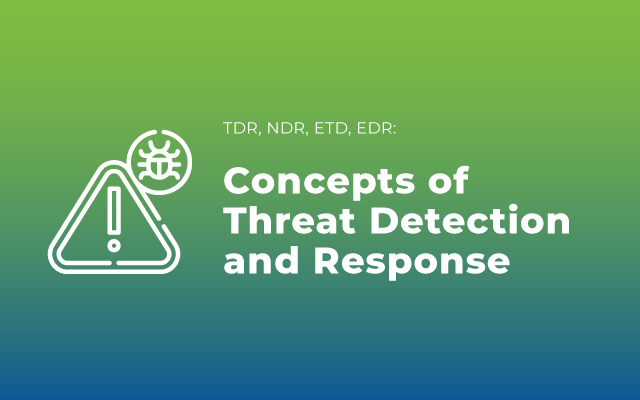Articles /
TDR, NDR, ETD, EDR: Concepts of Threat Detection and Response

What is Threat Detection and Response (TDR)?
Threat Detection and Response (TDR) is the practice of deep analysis of security ecosystems to identify bad actors or irregular behaviors that could lead to compromises on the network. TDR helps Managed Security Service Providers (MSSPs) and Security Operation Centers (SOC) teams detect malicious network activity and stop the movement of threats. Based on a zero-trust model, Threat Detection and Response serves as a cyber line of defense to assess, identify, and block hackers while limiting damages done when systems are penetrated.
Threat Detection and Response can refer to any advanced cybersecurity tool that analyzes the IT environment and identifies threats. Threat detection starts with time-sensitive discovery and mitigation of any discovered threats. An in-house security program or a qualified managed security services provider (MSSP) should operate 24/7 year-round to monitor the networks and allow for decisive and quick action to prevent attackers from breaching sensitive data repositories.
Threat Detection and Response will stop:
- Known threats detected based on signature
- Unknown, emerging threats detected with behavior-based detection tools
- Sophisticated malware threats
- Zero-day vulnerabilities
- Advanced persistent threats
Components of a Threat Detection Program
Organizations need to approach their cybersecurity posture from end to end to assess threats and terminate risks before they become issues. These considerations lead to a three-fold approach for a comprehensive threat detection program.Network Detection and Response (NDR)
Established by Gartner in 2020 as a category that grew from network traffic analysis, Network Detection and Response enables organizations to monitor traffic on their networks for suspicious activities and, in turn, respond to the detection of cyber threats. Network Detection and Response includes automatic capabilities such as blocking bad traffic at the firewall to manual responses such as incident response. As organizational data and analytics capabilities vastly expanded, network traffic was first monitored through a technology called Network Traffic Analysis (NTA), a staple service of security operation centers. Traffic analysis was no longer enough as the market evolved and broadened, and the category expanded to include network detection and response. Today, with the advancements in emerging technologies, NDR solutions harness advanced threat detection skills through artificial intelligence and machine learning. Network Detection and Response Benefits- Improved detection capabilities
- Capability to determine the confidence and risk level of a threat
- Increasingly automated tasks allow MSSPs to focus on triage and rapid response